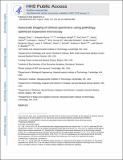| dc.contributor.author | Zhao, Yongxin | |
| dc.contributor.author | Bucur, Octavian | |
| dc.contributor.author | Irshad, Humayun | |
| dc.contributor.author | Chen, Fei | |
| dc.contributor.author | Weins, Astrid | |
| dc.contributor.author | Stancu, Andreea L | |
| dc.contributor.author | Oh, Eun-Young | |
| dc.contributor.author | DiStasio, Marcello | |
| dc.contributor.author | Torous, Vanda | |
| dc.contributor.author | Glass, Benjamin | |
| dc.contributor.author | Stillman, Isaac E | |
| dc.contributor.author | Schnitt, Stuart J | |
| dc.contributor.author | Beck, Andrew H | |
| dc.contributor.author | Boyden, Edward S | |
| dc.date.accessioned | 2021-10-27T19:57:33Z | |
| dc.date.available | 2021-10-27T19:57:33Z | |
| dc.date.issued | 2017 | |
| dc.identifier.uri | https://hdl.handle.net/1721.1/133995 | |
| dc.description.abstract | Expansion microscopy (ExM), a method for improving the resolution of light microscopy by physically expanding a specimen, has not been applied to clinical tissue samples. Here we report a clinically optimized form of ExM that supports nanoscale imaging of human tissue specimens that have been fixed with formalin, embedded in paraffin, stained with hematoxylin and eosin, and/or fresh frozen. The method, which we call expansion pathology (ExPath), converts clinical samples into an ExM-compatible state, then applies an ExM protocol with protein anchoring and mechanical homogenization steps optimized for clinical samples. ExPath enables ~70-nm-resolution imaging of diverse biomolecules in intact tissues using conventional diffraction-limited microscopes and standard antibody and fluorescent DNA in situ hybridization reagents. We use ExPath for optical diagnosis of kidney minimal-change disease, a process that previously required electron microscopy, and we demonstrate high-fidelity computational discrimination between early breast neoplastic lesions for which pathologists often disagree in classification. ExPath may enable the routine use of nanoscale imaging in pathology and clinical research. | |
| dc.language.iso | en | |
| dc.publisher | Springer Science and Business Media LLC | |
| dc.relation.isversionof | 10.1038/NBT.3892 | |
| dc.rights | Creative Commons Attribution-Noncommercial-Share Alike | |
| dc.rights.uri | http://creativecommons.org/licenses/by-nc-sa/4.0/ | |
| dc.source | PMC | |
| dc.title | Nanoscale imaging of clinical specimens using pathology-optimized expansion microscopy | |
| dc.type | Article | |
| dc.contributor.department | Massachusetts Institute of Technology. Media Laboratory | |
| dc.contributor.department | Massachusetts Institute of Technology. Department of Biological Engineering | |
| dc.contributor.department | McGovern Institute for Brain Research at MIT | |
| dc.contributor.department | Massachusetts Institute of Technology. Department of Brain and Cognitive Sciences | |
| dc.relation.journal | Nature Biotechnology | |
| dc.eprint.version | Author's final manuscript | |
| dc.type.uri | http://purl.org/eprint/type/JournalArticle | |
| eprint.status | http://purl.org/eprint/status/PeerReviewed | |
| dc.date.updated | 2019-07-19T13:27:29Z | |
| dspace.orderedauthors | Zhao, Y; Bucur, O; Irshad, H; Chen, F; Weins, A; Stancu, AL; Oh, E-Y; DiStasio, M; Torous, V; Glass, B; Stillman, IE; Schnitt, SJ; Beck, AH; Boyden, ES | |
| dspace.date.submission | 2019-07-19T13:27:30Z | |
| mit.journal.volume | 35 | |
| mit.journal.issue | 8 | |
| mit.metadata.status | Authority Work and Publication Information Needed | |
